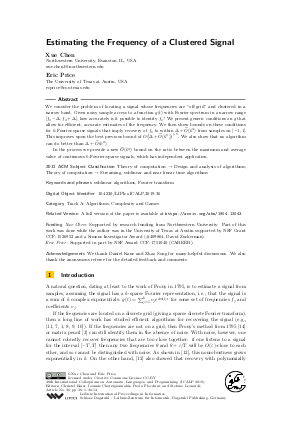Estimating the Frequency of a Clustered Signal
Authors Xue Chen, Eric Price
-
Part of:
Volume:
46th International Colloquium on Automata, Languages, and Programming (ICALP 2019)
Part of: Series: Leibniz International Proceedings in Informatics (LIPIcs)
Part of: Conference: International Colloquium on Automata, Languages, and Programming (ICALP) - License:
 Creative Commons Attribution 3.0 Unported license
Creative Commons Attribution 3.0 Unported license
- Publication Date: 2019-07-04
File

PDF
LIPIcs.ICALP.2019.36.pdf
- Filesize: 0.55 MB
- 13 pages
Document Identifiers
Related Versions
-
A full version of the paper is available at https://arxiv.org/abs/1904.13043.
Subject Classification
ACM Subject Classification
- Theory of computation → Design and analysis of algorithms
- Theory of computation → Streaming, sublinear and near linear time algorithms
Keywords
- sublinear algorithms
- Fourier transform
Metrics
- Access Statistics
-
Total Accesses (updated on a weekly basis)
0PDF Downloads0Metadata Views
Abstract
We consider the problem of locating a signal whose frequencies are "off grid" and clustered in a narrow band. Given noisy sample access to a function g(t) with Fourier spectrum in a narrow range [f_0 - Delta, f_0 + Delta], how accurately is it possible to identify f_0? We present generic conditions on g that allow for efficient, accurate estimates of the frequency. We then show bounds on these conditions for k-Fourier-sparse signals that imply recovery of f_0 to within Delta + O~(k^3) from samples on [-1, 1]. This improves upon the best previous bound of O(Delta + O~(k^5))^{1.5}. We also show that no algorithm can do better than Delta + O~(k^2).
In the process we provide a new O~(k^3) bound on the ratio between the maximum and average value of continuous k-Fourier-sparse signals, which has independent application.
Cite As Get BibTex
Xue Chen and Eric Price. Estimating the Frequency of a Clustered Signal. In 46th International Colloquium on Automata, Languages, and Programming (ICALP 2019). Leibniz International Proceedings in Informatics (LIPIcs), Volume 132, pp. 36:1-36:13, Schloss Dagstuhl – Leibniz-Zentrum für Informatik (2019)
https://doi.org/10.4230/LIPIcs.ICALP.2019.36
BibTex
@InProceedings{chen_et_al:LIPIcs.ICALP.2019.36,
author = {Chen, Xue and Price, Eric},
title = {{Estimating the Frequency of a Clustered Signal}},
booktitle = {46th International Colloquium on Automata, Languages, and Programming (ICALP 2019)},
pages = {36:1--36:13},
series = {Leibniz International Proceedings in Informatics (LIPIcs)},
ISBN = {978-3-95977-109-2},
ISSN = {1868-8969},
year = {2019},
volume = {132},
editor = {Baier, Christel and Chatzigiannakis, Ioannis and Flocchini, Paola and Leonardi, Stefano},
publisher = {Schloss Dagstuhl -- Leibniz-Zentrum f{\"u}r Informatik},
address = {Dagstuhl, Germany},
URL = {https://drops.dagstuhl.de/entities/document/10.4230/LIPIcs.ICALP.2019.36},
URN = {urn:nbn:de:0030-drops-106128},
doi = {10.4230/LIPIcs.ICALP.2019.36},
annote = {Keywords: sublinear algorithms, Fourier transform}
}
Author Details
Funding
- Chen, Xue: Supported by research funding from Northwestern University. Part of this work was done while the author was in the University of Texas at Austin supported by NSF Grant CCF-1526952 and a Simons Investigator Award (#409864, David Zuckerman).
- Price, Eric: Supported in part by NSF Award CCF-1751040 (CAREER).
Acknowledgements
We thank Daniel Kane and Zhao Song for many helpful discussions. We also thank the anonymous referee for the detailed feedback and comments.
References
-
A. Akavia, S. Goldwasser, and S. Safra. Proving hard-core predicates using list decoding. FOCS, 44:146-159, 2003.

- Haim Avron, Michael Kapralov, Cameron Musco, Christopher Musco, Ameya Velingker, and Amir Zandieh. A Universal Sampling Method for Reconstructing Signals with Simple Fourier Transforms. In Proceedings of the 51st annual ACM symposium on Theory of computing (STOC 2019), 2019. URL: http://arxiv.org/abs/1812.08723.
- Y. Bresler and A. Macovski. Exact maximum likelihood parameter estimation of superimposed exponential signals in noise. IEEE Transactions on Acoustics, Speech, and Signal Processing, 34(5):1081-1089, October 1986. URL: http://dx.doi.org/10.1109/TASSP.1986.1164949.
- Xue Chen, Daniel M. Kane, Eric Price, and Zhao Song. Fourier-sparse interpolation without a frequency gap. In Foundations of Computer Science(FOCS), 2016 IEEE 57th Annual Symposium on, 2016. URL: http://arxiv.org/abs/1609.01361.
-
Xue Chen and Eric Price. Active Regression via Linear-Sample Sparsification. In the 32nd Annual Conference on Learning Theory (COLT 2019), 2019.

-
Herman Chernoff. A measure of asymptotic efficiency for tests of a hypothesis based on the sum of observations. The Annals of Mathematical Statistics, 23:493-507, 1952.

-
Anna C Gilbert, Sudipto Guha, Piotr Indyk, S Muthukrishnan, and Martin Strauss. Near-optimal sparse Fourier representations via sampling. In Proceedings of the thirty-fourth annual ACM symposium on Theory of computing, pages 152-161. ACM, 2002.

-
Anna C Gilbert, S Muthukrishnan, and Martin Strauss. Improved time bounds for near-optimal sparse Fourier representations. In Optics &Photonics 2005, pages 59141A-59141A. International Society for Optics and Photonics, 2005.

-
Haitham Hassanieh, Piotr Indyk, Dina Katabi, and Eric Price. Simple and practical algorithm for sparse Fourier transform. In Proceedings of the twenty-third annual ACM-SIAM symposium on Discrete Algorithms, pages 1183-1194. SIAM, 2012.

-
Piotr Indyk and Michael Kapralov. Sample-Optimal Fourier Sampling in Any Constant Dimension. In Foundations of Computer Science (FOCS), 2014 IEEE 55th Annual Symposium on, pages 514-523. IEEE, 2014.

-
Y. Mansour. Randomized Interpolation and Approximation of Sparse Polynomials. ICALP, 1992.

-
Ankur Moitra. The threshold for super-resolution via extremal functions. In STOC, 2015.

-
Eric Price and Zhao Song. A Robust Sparse Fourier Transform in the Continuous Setting. In Foundations of Computer Science (FOCS), 2015 IEEE 56th Annual Symposium on, pages 583-600. IEEE, 2015.

-
R Prony. Essai experimental et analytique. J. de l’Ecole Polytechnique, 1795.

